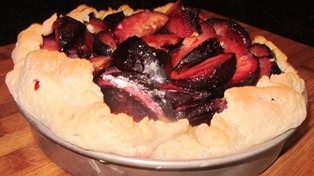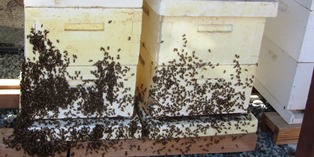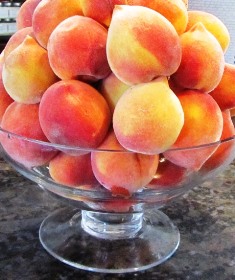Archive for the 'Cobblers, Crumbles, and Crisps' Category
Puzzling through a Cozy, Weeping at a Memoir, and Forgetting the Peach Pie
I couldn’t breathe in yesterday’s heat. But with so much work to be done around the farmette, I soldiered on, staking heirloom blue tomatoes. I hadn’t finished canning my organic apricots and now the plums and peaches were ready. I felt overwhelmed and longing for cool spot to sip tea, rest, and read.
We had already removed the apricots from our “torture tree” since we’ve been unable to surmount its many problems after planting it five years ago. Carlos wasted little time chain-sawing it down. I deadheaded the roses, while he dug out the stump.
Then with a clear view to our hives, we quickly realized that the we needed to suit up and install extenders or the bees would swarm. Even as we felt the urgency, we realized there were also dozens of other chores screaming for our attention.
I told myself that breezes would soon blow inland from the Carquinez Strait, a channel of the San Francisco Bay where the San Joaquin and the Sacramento Rivers flow to the ocean, but by mid-afternoon, nary a leaf moved on the apricot, plum, and pomegranate trees. By four o’clock when the wind finally did kick in–the air wasn’t cool as it usually was. The winds blew strong and stifling hot and threatened to suffocate anyone still working outside.
Abandoning the outside chores, I retreated indoors and turned on the air conditioner. Seeing the lug of apricots and crock of peaches resting on the kitchen counter, I groaned. The jam had to be made, but I couldn’t face stirring boiling fruit on a hot stove.
Deciding to use up some of the fruit for a simple after-dinner dessert, I flipped through the pages of a few cookbooks. Maybe a cobbler would do or a peach pie. I really didn’t need a recipe for those, but in Country Cooking by Dori Sanders, I found an intriguing raisin-cinnamon crust that sounded tasty. I bet it would go with peaches but I probably could have baked it on the patio floor.
With a glass of sweet tea and an armload of paperbacks and hardcovers, I curled up on the couch and finished reading Murder is Binding, Lorna Barrett’s debut book in her cozy Booktown Mystery series. I love this author and her writing, but soon figured out who done it. Still, I read to the end; you never know when a clever twist might show up.
Next, I read the last few pages of A Tuscan Childhood by Kinta Beevor. At bedtime, I’d been savoring the chapters of that book like pieces of rich, dark chocolate. Beevor’s evocative descriptions of her bohemian childhood in Tuscany captured my imagination, drawing me in so completely I could almost smell the wild thyme, pine needles, and rocky Tuscan terrain in the searing, summer heat. Like Frances Mayes (Under the Tuscan Sun), who wrote a quote for the cover, I felt sad when Beevor’s lovely memoir ended.
Returning to the stack, I selected another memoir, The Orchard, by Theresa Weir. I’d bought the book on impulse during a trip to the farmers’ market at Todos Santos Plaza, our downtown green space surrounded by bars and banks and, of course, a second-hand bookstore. Drastically marked down, the book had been summarily deposited on a set of moveable shelves, and rolled outside the storefront for a quick sale.
The artist and writer in me understood immediately why I had picked it up and purchased it: the cover art pictured a young couple in a loving embrace, standing in lush green grass surrounded by apple trees. But there was something in that image that evoked sadness, like a bittersweet dream of a time past, viewed through a long lens.
As the descendant of five generations of farmers, I suspected Weir’s book would resonate with my own experiences of farm life in America’s heartland with bone-chilling winters of snow and ice and sweltering summers when you prayed for rain. What I didn’t expect was exquisite writing and the juxtaposition of love against the deadly realities of widespread pesticide use on the farms that ushered me into her story and swept me along. I finished that book in one sitting and will long be haunted by it.
I felt guilty for having only paid pennies for Weir’s book. A pittance for a tale that evolved out of all she had lived through. Less than the price of bus fare to journey with her as she pieced together scenes from her life in the Heartland. In every page, I was with her as she struggled, never abandoning her dreams. She learned as I had how to tuck them away while you dealt with the realities of a hard life with heart-breaking lows and highs that reached euphoria. But there were scenes she left out, only hinting at experiences she said she would “never talk about.” The truth is, I wept after putting down her book.
When a reader identifies so closely with a character in a story (and this was Weir’s personal narrative of her life), he or she rides the emotional ups and downs with that character. Good writers understand how to tug at their readers’ emotions and milk the drama. Theresa Weir had skillfully threaded a leitmotif of darkness and light, joy and sorrow, pain and healing through her story, but never once did I feel manipulated. Every sentence of The Orchard rang true.
I couldn’t read anymore after putting that book down. As I made dinner, I thought of how many scenes in her life resonated with mine. Even the widespread pesticide use on farms and the stubbornness of farmers to change.
I thought about Rachel Carson’s famous book, Silent Spring, that sounded the wake-up call to farmers everywhere about the dangers of chemicals in fertilizers, pesticides, and herbicides. So many small farms have been overtaken by agribusinesses these days and still the chemicals are used. I decided to forgo making the peach pie.
With the heat of the day gone, I opened the windows and stretched out between freshly washed sheets. I listened to the rustle of oak and eucalyptus leaves. To crickets and the unseen critters that make noises in the night. I listened to the soft voices of my Lebanese neighbors chatting in their orchard with relatives.
As dreams beckoned, I could almost smell the fresh lilacs that Theresa Weir had written about in her memoir. Their cloying scent had filled her grandmother’s kitchen just as they had filled my grandmother’s, my mother’s, and mine. I wondered if the lilacs would ever disappear or if the world would one day wake up to find the honeybees gone, the fruit trees without fruit, and the berries and other sweet produce in our gardens and orchards reduced to a memory.
Oats–Farm Cooking Staple Lowers Cholesterol
Steel-cut (Irish) and stone-ground (Scottish) oatmeal has a place on my pantry shelf alongside a container of quick oats. Steel cut means the groats (oat grains) get cut by a steel blade after they have been hulled. The groats of stone-ground oats are cut even smaller than the steel-cut and ground. See http://wholegrainscouncil.org/whole-grains-101/types-of-oats
In rolled oats, the groats are further flattened into flakes. But whether you eat steel-cut oatmeal that takes up to a half hour or more to cook or rolled oats that cook in minutes, you can take comfort in the fact that you are doing something good for your body.
Studies have shown that oatmeal can lower cholesterol, and lower cholesterol reduces the risk of heart disease. Steel-cut oats taste about the same as quick oats and nutritionally, the two two are also similar. See http://www.mayoclinic.com/health/cholesterol/CL00002e
Growing up n a farm, oatmeal made its way to our table on a regular basis. The women in our family also used oatmeal to create sweet treats–cookies and old fashioned deserts. Their crumbles, crisps, and betties incorporated oats in a pastry type topping laid over fruit and baked.
A crumble topping that adds oatmeal and nuts to the flour is known interchangeably as crumble or crisp. Betty is the name applied if the fruit used is an apple variety prepared with sugar, spices, and bread crumbs. The term dates to Colonial America. Sugar sweetens the crumble and butter makes it hang together in a pastry with a crumbly texture.
Here’s an example of how oatmeal might be used in a fruit crumble, crisp, or betty recipe. After sprinkling the topping onto the fruit, the dessert is baked at 375 degrees Fahrenheit for 30-35 minutes.
Ingredients for fruit filling:
6 cups cherries, apples, pears, mixed berries, or other fruit
1 cup sugar (or more, if the fruit is very tart)
1 teaspoon lemon juice (keeps the fruit from turning brown)
1 teaspoon cornstarch (use more if the fruit is very juicy and requires a thickening agent)
1 teaspoon spice such as nutmeg, ginger, or cinnamon, depending on the fruit used
Directions:
Mix fruit and ingredients together and pour into a baking dish.
Ingredients for the crumble/crisp topping:
1 cup flour
1/2 cup oats (optional)
1/2 cup chopped nuts (optional)
1/2 cup brown sugar
1/2 teaspoon baking powder
1/4 teaspoon salt
1/4 teaspoon spice (like cinnamon or ginger, depending on the type of fruit used)
1/2 cup butter (8 Tablespoons)
Directions:
Mix together the dry ingredients and cut in the butter until crumbly. Sprinkle on top of the fruit and bake for 30-35 minutes.
Rustic Pluot or Plum Tart with Italian Crostata Crust

Pluots or plums are first drizzled in lemon juice and dusted with flour, then placed into the tart with bits of butter
The farmer’s market has the dark purple-black plums and pluots in abundance now, so I thought I’d buy a few and whip up a rustic summer tart, Italian style.
I like the rustic tarts with the Italian style crostata crust because they are easy to make and the tart tastes so buttery and flaky. This recipe uses butter and also cream cheese that gives the tart a special lightness. For the filling, I used pluots for this one, but you could also use ripe plums.
To make the dough, I find it easier to just put the ingredients into the food processor with a steel blade and pulse a few times, adding ice water as needed.
Ingredients:
8 ounces cream cheese
2 sticks butter (1 cup)
2 cups flour
½ teaspoon salt
1 teaspoon cold water
6-7 large sweet pluots or dark plums
Juice from ½ medium lemon
2 Tablespoons butter
2 Tablespoons flour
Directions:
Preheat oven to 375 degrees Fahrenheit.
In a food processor with blade, process cream cheese, butter, flour, salt, and water into a ball.
*Roll out on a lightly floured surface in a circle to about ¼ inch thickness and 2-4 inches larger than your tart pan.
Place dough in a tart pan and pre-bake 10 minutes.
Wash, cut, stone, and cut pluots/plums into quarters.
Combine with lemon juice.
Toss with flour. If plums are juicy, you’ll need a bit more flour to absorb all that juice.
Cut butter into pieces and scatter around the plums as you layer the slices in the pan on top of the crostata dough.
Fold extra dough loosely back over the plums; it should not reach the center because you want a rustic look to the baked tart.
Bake for 30-45 minutes until pluots/plums are soft and dough is golden brown.
Serve warm with a dollop of whipping cream or a good vanilla ice cream.
*Avoid over-handling the dough as it will become tough.
Fresh Peaches Make Yummy Upside Down Cake
When our Desert Gold peach trees produced a few peaches at the end of May, we picked and ate all of them.
Now it’s the middle of July, and the Elberta peaches have ripened. Many have fallen from the tree. Over the last week, I picked most of those yellow-fleshed, honey sweet fruits and made peach preserves. With the remaining peaches hanging on the tree and about to drop, I am going to make a peach upside down cake.
The recipe looks long, but it is easy to follow and the cake is reminiscent of the upside down cake my grandmother used to make on her farm, located between Columbia and Booneville, in central Missouri. She always served it with homemade ice cream, made from fresh (cow’s milk) cream. For a quick substitute, you can use a quality vanilla ice cream to complement the taste of the warm peach cake.
Peach Upside Down Cake
Ingredients:
Three to four large peaches, peeled, stone removed, and sliced to produce 2 cups of fruit
½ cup light brown sugar, packed
1 teaspoon cinnamon
3 Tablespoons butter
1 ¾ cup all-purpose white flour
¼ teaspoon of salt
2 teaspoons baking powder
½ teaspoon cinnamon
½ cup butter (room temperature)
¾ cup granulated sugar
2 large eggs
½ teaspoon vanilla extract
¼ teaspoon almond extract
2/3 cup milk
Directions:
Preheat oven 325 degrees Fahrenheit
Grease a 9-inch square cake pan with butter.
Wash, peel, and remove pits of peaches; cut peaches into thin slices.
Combine brown sugar, 1 teaspoon of cinnamon, and 3 Tablespoons melted butter.
Add the peaches and toss to coat.
Arrange the peach mixture in the prepared baking pan.
Directions for making the cake batter:
Combine the flour, salt, baking powder, and ½ teaspoon cinnamon in a bowl.
Cream butter and sugar in a separate bowl and add eggs, vanilla extract, and almond flavoring.
Beat until well mixed.
Add the flour mixture to the creamed butter and sugar mixture, alternating with the milk, beating after each addition to blend.
Assembling:
Spoon the cake batter over the peach slices taking care to spread evenly until peaches are all covered.
Bake for 55 to 65 minutes. A toothpick inserted in the center of the cake should come out clean.
Remove from oven and invert onto a cake plate. Allow 5 minutes for the cake to pull away from the pan and drop onto the plate. Then gently remove the cake pan. Scrape any peach slices stuck in the pan onto top of cake.
Serves six.
Blackberries and Dumplings
I dug up ensnarled blackberry vines yesterday and threw the lot into a bucket for replanting elsewhere on the farmette. Originally planted next to a fence, the vines had, over the last year, tangled into the roses and lavender that I had planted too near to them. Blackberry vines have a habit of spreading.
While cutting the vines, I recalled the blackberries and dumplings that my grandmother used to make in her small, but utilitarian farm kitchen near Booneville, Missouri.
We would set off in the early morning to gather the blackberries that grew in thickets around the farm. When our galvanized pails of berries grew heavy, we’d trudge back to the farmhouse.
My job was to wash the berries while my grandmother took a blue-striped yellow ware mixing bowl from the old Hoosier cabinet and began assembling the dry ingredients to make dumplings.
Dumpling ingredients:
1 cup all-purpose white flour
1 1/2 teaspoons baking powder
1/2 teaspoon salt
1/2 teaspoon baking soda
1 cup, plus 1 Tablespoon sugar
1 large egg (with yolk separated from egg white)
2/3 cup buttermilk
3 Tablespoons of butter (2T for dumpling batter, 1T for skillet)
Two pints of freshly washed blackberries
Directions for making the dumplings:
Combine flour, baking powder, salt, baking soda, and a Tablespoon of the sugar.
Mix together in another bowl the egg yolk, buttermilk, and 2 Tablespoons of butter.
Slowly combine the wet ingredients into the dry.
Beat the egg white until peaks rise and then fold it into the dumpling batter.
Directions for cooking:
In a 10-inch cast-iron skillet over medium high heat, melt 1 Tablespoon of butter. Using a large spoon, drop half dozen or so of the dumpling batter into the butter and cook about five minutes until both sides are brown. Remove this batch and repeat until all batter is cooked. Then set the dumplings aside.
Pour the blackberries into the skillet with 1 cup sugar. Mix together until the berries and sugar simmer and then reduce the heat. Position the dumplings on top of the blackberries and cook for ten minutes. The dessert is best served warm. Serves 4 to 6.
 Facebook
Facebook Goodreads
Goodreads LinkedIn
LinkedIn Meera Lester
Meera Lester Twitter
Twitter








